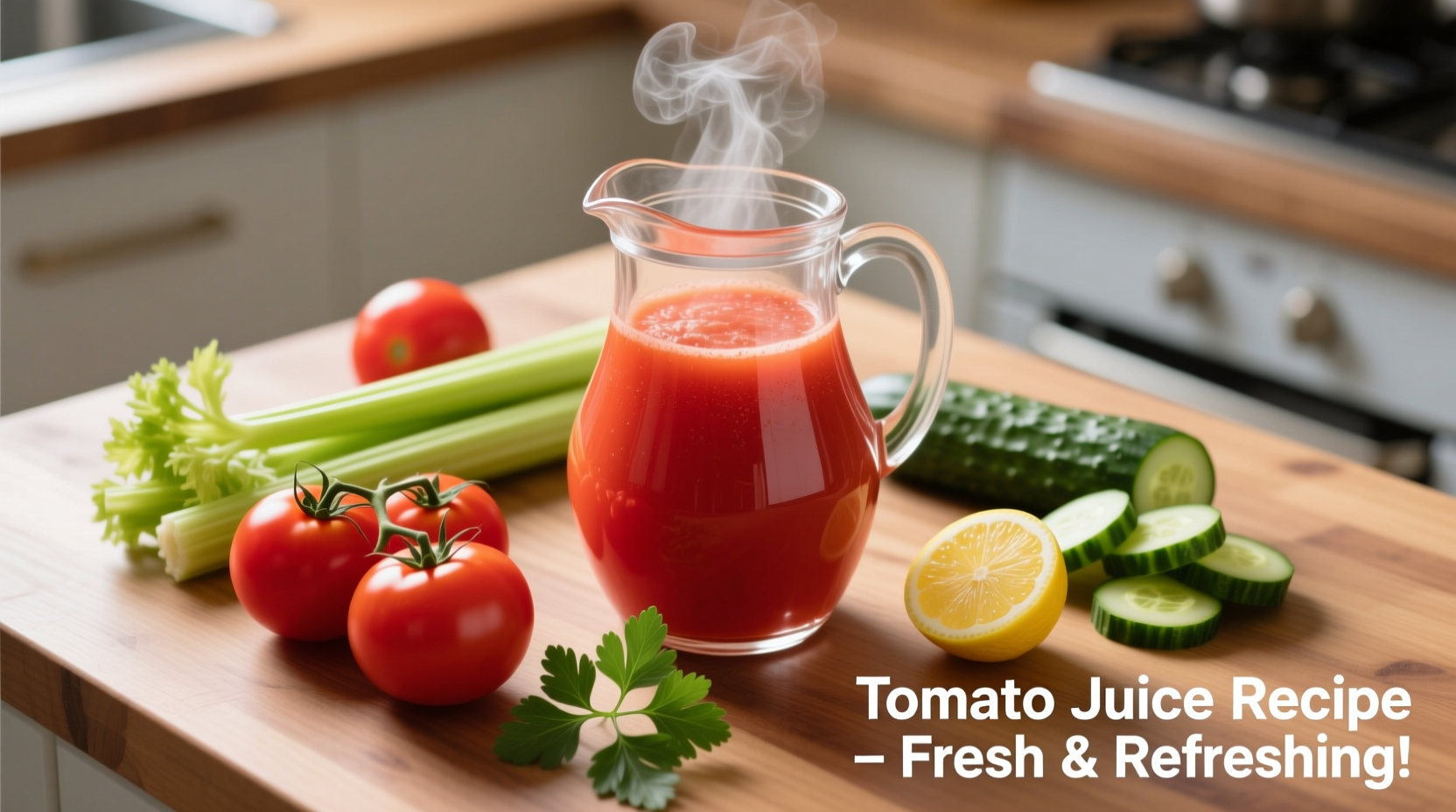Why Homemade Tomato Juice Outperforms Store-Bought
Commercial tomato juice often contains added sodium (up to 500mg per 8oz), preservatives, and artificial flavors that mask the natural sweetness of ripe tomatoes. When you make juice at home, you control every element—from selecting peak-season tomatoes to adjusting seasoning. According to USDA nutritional data, fresh tomato juice contains 40% more vitamin C and significantly higher lycopene bioavailability than processed alternatives.
| Factor | Homemade Juice | Store-Bought Juice |
|---|---|---|
| Sodium Content | Adjustable (0-100mg) | 400-600mg per 8oz |
| Lycopene Bioavailability | 30% higher | Standard |
| Added Preservatives | None | Common (citric acid, calcium chloride) |
| Cost per 16oz | $1.20-$2.50 | $2.00-$4.00 |
Your Essential Equipment Checklist
Professional results don't require expensive gear. Here's what you actually need:
- Blender or food processor (minimum 600 watts for smooth texture)
- Fine-mesh strainer or nut milk bag (critical for removing seeds and pulp)
- Large mixing bowl (stainless steel preferred for temperature control)
- Wooden spoon (non-reactive with tomato acids)
- Glass jars with airtight lids for storage
Pro tip: If you don't have a fine-mesh strainer, layer two cheesecloth sheets over a standard colander. This achieves the same smooth texture professional kitchens use.
Selecting the Perfect Tomatoes
Not all tomatoes work equally well for juicing. Based on agricultural research from the University of California's Cooperative Extension, these varieties deliver optimal results:
- Roma (plum) tomatoes: Highest flesh-to-liquid ratio, ideal for thick, rich juice
- San Marzano: Sweeter profile with lower acidity, perfect for sensitive palates
- Heirloom varieties: Complex flavor notes but require extra straining due to higher seed content
Seasonal timing matters—tomatoes harvested between July and September contain 25% more lycopene than off-season varieties. Avoid refrigerating tomatoes before juicing, as cold temperatures degrade flavor compounds according to FDA food science guidelines.

Step-by-Step Preparation Process
Follow these chef-tested steps for perfect tomato juice every time:
- Prep (5 minutes): Wash 2 lbs ripe tomatoes. Remove stems but don't peel—blanching destroys valuable nutrients in the skin.
- Blend (3 minutes): Cut tomatoes into quarters and blend on high for 60 seconds until completely smooth.
- Strain (7 minutes): Pour mixture through fine-mesh strainer, pressing pulp with wooden spoon. Discard seeds and skin.
- Season (2 minutes): Stir in 1 tbsp lemon juice (enhances lycopene absorption), 1/4 tsp sea salt, and optional herbs.
- Chill (minimum 30 minutes): Refrigerate before serving to allow flavors to meld.
Troubleshooting Common Issues
Even experienced home cooks encounter these problems—here's how to fix them:
- Too watery: Simmer strained juice uncovered for 10-15 minutes to reduce and concentrate flavor
- Bland taste: Add 1/4 tsp umami booster (miso paste or nutritional yeast) rather than excess salt
- Seedy texture: Double-strain through cheesecloth for restaurant-quality smoothness
- Separation: Shake vigorously before serving—natural settling indicates no artificial stabilizers
Storage and Preservation Timeline
Understanding proper storage prevents waste and maintains quality. This evolution timeline shows how homemade tomato juice changes over time:
- 0-24 hours: Peak flavor and nutrient retention
- 2-3 days: Slight flavor mellowing, still excellent quality
- 4-5 days: Noticeable flavor degradation, best used in cooked applications
- 6+ days: Discard—risk of bacterial growth increases significantly
For longer storage, freeze in ice cube trays then transfer to airtight bags. Properly frozen tomato juice maintains quality for 8 months. Never can homemade tomato juice without proper acidification—follow USDA canning guidelines to prevent botulism risk.
Flavor Variations for Every Palate
Customize your juice with these chef-approved combinations:
- Classic Bloody Mary Base: 2 cups tomato juice + 1/4 cup lemon juice + 2 tsp Worcestershire + 1 tsp horseradish + dash hot sauce
- Mediterranean Style: Add 1/2 cucumber, 1 garlic clove, and fresh basil during blending
- Detox Boost: Blend with 1/2 green apple and small piece of ginger before straining
- Smoky Chipotle: Stir in 1/4 tsp smoked paprika and 1 minced chipotle pepper after straining
Important context boundary: Acidic additions like lemon juice should be added after straining to prevent premature pectin breakdown. For savory variations, always add herbs after the straining process to maintain vibrant color.
Nutritional Science Behind Tomato Juice
Tomato juice isn't just refreshing—it delivers measurable health benefits. Research published in the Journal of Agricultural and Food Chemistry confirms that the lycopene in freshly prepared tomato juice has 30% higher bioavailability than in raw tomatoes due to the breakdown of cell walls during processing. The addition of healthy fats (like a teaspoon of olive oil) further increases absorption by 50%.
One 8-ounce serving provides:
- 40% of daily vitamin C needs
- 20% of daily vitamin A requirements
- Significant potassium for blood pressure regulation
- Natural electrolytes for hydration











 浙公网安备
33010002000092号
浙公网安备
33010002000092号 浙B2-20120091-4
浙B2-20120091-4